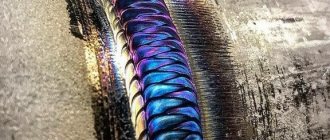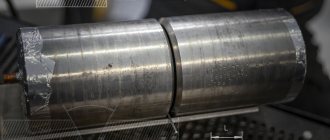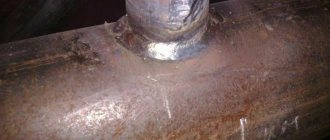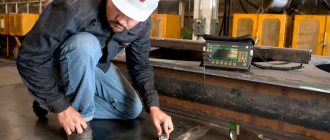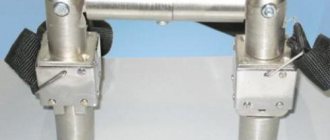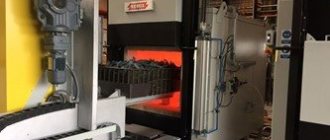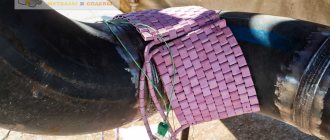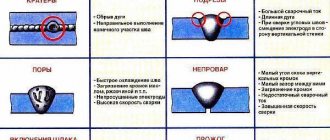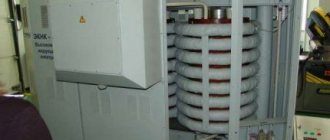Metal structures welded from metal are in demand in various spheres of life. However, during welding work, various types of weld defects may occur. They shorten the possible service life of the connection and reduce the safety level of the finished product.
Types of weld defects
All tolerances on weld dimensions are regulated by GOST requirements for each type of welding. Any deviations of the readings from the approved standards are considered to be defects. They can be a consequence of errors in the process of both preparation and execution of welding work.
Most defects in a welded joint have a negative impact on its strength characteristics. All defects are divided into three groups:
- external _ The main indicators are irregular joint shape, cracks, sagging, craters, seam undercuts, burns and other visual signs that can be detected on the surface. They are visible upon careful visual inspection and only a few can be noticed at first glance;
- internal . Defects are incomplete or uneven fusion of metals, cracks or porosity in the structure, the presence of foreign inclusions - slag, oxide, non-metallic impurities; other flaws located inside the seam;
- end-to- end Cracks, undercuts, burns and other damage that are end-to-end and visible on both sides.
Any defects are grounds for rejection of the work and must be corrected. This rule is especially relevant for supporting metal structures - frames, frames, sheathing, etc. They must be welded flawlessly to withstand the expected loads. Otherwise, the structures may become a source of danger to others.
Group 1. Cracks
Defects of type 100 or “E” are considered unacceptable. In the zone of crack formation, the structure will certainly collapse. The rupture occurs in the seam itself or in the immediate vicinity. When a crack occurs, the opening may be minimal, but the action of loads leads to rapid destruction. According to statistics, this type of defect appears when welding alloy and carbon steels. The risk of cracks increases when the weld cools quickly.
The reason for the formation of cracks is the presence of carbon, silicon, sulfur, nickel or hydrogen in the metal. If the technology is not followed, excessive stress occurs in the seam area. To eliminate cracks that have already formed, you must first drill their ends. Then the crack is removed by planing, and the place where it is located is cleaned and welded again.
Cracks can be classified by origin; they are divided into cold and hot.
- Cold cracks form after the seam has cooled, when the temperature is 300°C degrees. Such defects can manifest themselves after quite a long time. Phase transformations that occur during metal crystallization sharply reduce strength indicators. Atomic hydrogen does not completely evaporate and causes cracks to appear. This can only be avoided by ensuring protection of the weld pool.
- Hot cracks occur at high temperatures (1100-1300°C degrees). During crystallization, a process occurs that is the opposite of linear expansion. Pulling the metal together causes it to rupture. This type of crack is directed not only along the seam, but also across it. Discontinuities form at the boundaries of crystal grains.
Cracks can be divided by size. Macroscopic cracks (100; E) are assessed visually. Microcracks (1001) appear only when using magnifying devices. Often it is necessary to use fifty times magnification to observe the defect.
Classification of defects in welded joints
Not in every case is it possible to achieve ideal quality of the welded joint. If desired, you can find deviations from the established requirements. The full classification of welded joints is set out in paragraphs of GOST 30242-97. The document contains information about all possible flaws. Of these, we can highlight some that are most often encountered during control inspection of connecting joints.
Cracks
Cracks have the greatest negative impact on the quality of the weld. Potentially, they are the most dangerous, since they can cause rapid destruction of the entire structure, which in turn can lead to tragedy.
Cracks appear for various reasons:
- the joints are positioned incorrectly;
- the welding site was sharply cooled;
- incorrectly selected consumables;
- the metal crystallized due to excessively high temperature.
Based on the method of formation, cracks can be longitudinal, transverse or radial, and based on size, it is customary to distinguish between macro- and microcracks. Regardless of the type, causes and method of formation, a crack is an unacceptable defect.
Undercuts
Visually, the flaw is a longitudinal depression on the outer part of the seam. Due to the undercut, the cross-section of the seam is reduced and internal joint stress is generated. The strength of such a seam is highly questionable. The main reason for the formation of a defect is an overestimated welding current. Most often, undercuts are characteristic of horizontal seams.
Surges
Excess melt flows onto the surface of the workpiece, cools and forms a false bead. This is an influx that does not have strong fusion with the working surface. Most often, a defect is formed during horizontal welding of butt or fillet welds. The reason for their formation is insufficient heating of the base metal, due to excess filler material or scale on the edges of the mating surfaces.
Burns
A flaw is a through hole that is formed due to metal leaking out of the weld pool. As a rule, an influx forms from the reverse side. Burn-through is caused by too slow movement of the electrode along the joint line, too much current, insufficient thickness of the gasket or its loose fit, or a large gap between the parts.
Lack of penetration
If there are areas between the seams and the base metal where lack of fusion between them is visible, then this is a lack of fusion. That is, the base metal did not warm up properly to form a single whole with the melt. Such a defect greatly reduces the strength characteristics of the connection and the entire structure as a whole. The reason for lack of penetration may be too high a speed of movement of the electrode, poor preliminary preparation of the edges, the presence of scale, rust and other contaminants on the surface of the workpieces being joined.
Craters
Small depressions in the weld bead are formed as a result of a break in the welding arc. Defects lead to a reduction in the cross-section of the joint, which reduces its strength. The secondary danger of the crater is that its bottom may have additional loose inclusions, leading to the appearance of cracks.
Fistulas
Flaws are surface defects in the form of cavities. They reduce the strength of the joint and are additionally dangerous because they can provoke the formation of cracks. Fistulas are characterized by an arbitrary shape and can form both on the outside and on the inside.
Pores in the weld
Gas-filled pores may form during the welding process. The reason for their occurrence is various contaminants on the surface of the workpiece, high speed of electrode movement, and too high carbon content in the filler material.
Foreign inclusions
The quality of the weld is significantly reduced due to foreign inclusions - slag, flux, oxide, tungsten and others. The main reason that causes them is an incorrectly selected welding mode.
What is called a burn-through?
The defect occurs due to the leakage of weld pool metal through a hole in the seam formed as a result of through penetration. Sagging appears on the reverse side.
Reasons leading to burns:
- insufficient welding speed;
- increased power of the welding flame;
- loose connection of the lining to the main metal and its insufficient thickness;
- excessive welding current;
- increased gap between edges;
- power supply stop;
- welder's carelessness.
Causes of weld defects
Any defect is formed due to a certain factor. There are different reasons for the formation of weld defects:
- During the work, low-quality consumables were used;
- the technology for performing welding work was not followed;
- low quality metal used to create the welded structure;
- equipment malfunction or poor quality work;
- incorrectly selected welding mode;
- technological errors were made due to the low qualifications of the specialist.
To obtain a high-quality metal structure, strict adherence to technological parameters and welding standards is required, and specialists with a sufficient level of qualification are involved in the work.
Group 6
All other defects that are not included in the previous groups are positioned as defects 600. These include random arcing, spattering, scuffing and reduction in metal thickness. Despite the wide variety of welding seam defects, very specific recommendations have been developed to prevent them.
It will be difficult for a novice welder to comply with all the requirements, but professional welders can easily avoid poor-quality results. It is necessary to initially develop a welding technique. To do this, it is necessary to resolve such issues as the choice of equipment, the choice of consumables, proper surface treatment, and welding techniques.
Defect detection methods
Various methods are used to identify weld defects:
- joint measurements and visual inspection;
- checking connections for leaks;
- searching for defects using special instruments;
- laboratory tests of samples for strength.
Visual determination of the quality of the weld is carried out only after thoroughly cleaning its surface from slag, eliminating various contaminants and frozen metal spatters. The dimensions, shape, and presence of defects are checked - burns, fistulas, cracks, craters and other flaws.
Thanks to leakage tests, it is possible to determine the presence or absence of pipeline defects - pores, cracks, lack of fusion. The tightness of the structure is checked in the following ways:
- air blowing;
- filling with water under pressure;
- kerosene treatment.
If a defect is detected, additional processing is required to eliminate it.
Methods for eliminating defects in welded joints
Regardless of the equipment involved - inverter, classic device, transformer, etc. - the formation of defects is not excluded. It is customary to distinguish between so-called acceptable and unacceptable welding defects. Depending on the type and complexity of the defects, the suitability of the finished product for use is determined.
Designs that are not approved for use are sent for revision. How the defect will be eliminated depends on the type of defect:
- the burn is welded after thoroughly cleaning the welded joint;
- undercuts are eliminated by applying a thin overlay along the entire length of their formation;
- the area with the crack is drilled out, the body of the seam is cut out, the surface is cleaned and degreased. After this, the recess is welded;
- incomplete brews are cut out and re-brewed;
- fistulas and craters are eliminated using the same scheme. First of all, everything is cut down to the base metal. After this, the joint is welded in a new way;
- the sagging should be carefully cut off, checking for any lack of penetration;
- deformed areas are leveled by heating or mechanically;
- any of the defects, implying the presence of foreign inclusions, is eliminated by cutting out the seam (section) and applying a new one.
If during the inspection process defects in the technological nature of pipe connections are discovered, correction is carried out using one of the following methods:
- mechanically without welding;
- mechanically in combination with welding of the defective area;
- cutting out a section of the pipeline containing a technological defect;
- the seam is completely removed and the joint is welded in a new way.
The strength and tightness of gas supply networks is restored by arc welding. The use of gas welding installations is not permitted.
